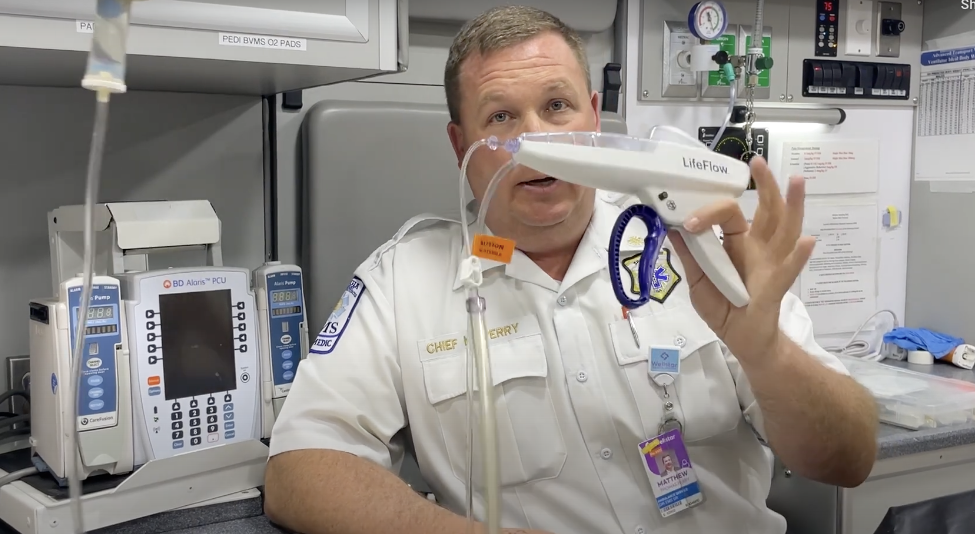
Emergency medical services (EMS) providers are often the first line of care for patients experiencing critical illness, including septic shock. These patients benefit greatly from the prompt identification of shock symptoms and initiation of rapid fluid volume replacement. With more than 40% of all severe sepsis hospitalizations arriving at the emergency department by EMS transport, there is a significant opportunity to improve pre-hospital care for patients in septic shock.1
Maintaining adequate perfusion to the brain and vital organs is paramount to the patient’s chance of survival. Administering fluids to increase blood pressure significantly reduces mortality rates and is one of the most effective pre-hospital interventions for septic shock.2
However, traditional equipment often limits first responders’ ability to perform sufficient fluid resuscitation during transport. Common infusion techniques like digital IV pumps, pressure bags, and the push-pull method cannot deliver fluids quickly enough for EMS teams to reassess the patient and begin additional interventions as needed before arriving at the hospital.3,4 This often complicates matters for ED providers who must first stabilize patients with fluid resuscitation before moving on to more advanced treatment.
The following cases and data illustrate the effectiveness of the LifeFlow rapid infuser in administering fluids to patients experiencing symptoms of septic shock in the pre-hospital setting.
Case Presentation & Management
Below is a table containing data from Wellstar Spalding Medical Center EMS for three recent patient encounters. Each of the patients was identified as being in septic shock and presented with significant hypotension. Transport time for all three patients was less than 20 minutes, and a peripheral IV was used for fluid administration.

This data highlights a broader trend observed by Wellstar, which demonstrates the effectiveness of the LifeFlow rapid infuser for effectively treating septic shock symptoms and enabling earlier reassessment.
Wellstar has seen significant benefits from implementing LifeFlow in its pre-hospital treatment playbook. A sample of 50 recent patient cases involving LifeFlow saw an average of 1,600 mL of crystalloid fluids administered. The literature suggests that, on average, pre-hospital sepsis patients receive between 300 mL to 500 mL of fluids.5
Moreover, of all Wellstar EMS cases involving LifeFlow so far in 2024, only one patient passed away before leaving the hospital.
Discussion
Pre-hospital care plays a pivotal role in the management of septic shock where early intervention has a significant positive impact on patient outcomes.1 Prompt administration of fluids is crucial to restoring adequate tissue perfusion and improving patient survival rates.
EMS providers are at the forefront of initial patient care yet often face challenges such as limited time and resources during transport. Traditional methods of fluid administration may not deliver fluids quickly or consistently enough to meet the urgent needs of septic shock patients. These methods can delay necessary treatments and compromise patient stabilization.
The LifeFlow rapid infuser addresses these challenges by enabling EMS providers to deliver fluid boluses swiftly and accurately. Designed for ease of use in dynamic and time-sensitive environments, LifeFlow allows Wellstar EMS providers to start an infusion in under two minutes and deliver 1,000 mL of fluid in as little as four minutes through a 20g IV. This capability is critical in preventing further deterioration and preparing patients for advanced care upon arrival at the hospital.
Matthew Perry, the EMS Director at Wellstar Spalding Medical Center, says, “The resuscitation we are able to provide using LifeFlow gives patients a greater chance of survival, without question. Giving a fluid bolus in minutes gives us an opportunity to perform quality reassessments and allows for a faster transition to vasopressive drugs as needed.”
“This all points toward thorough patient care and continues to prove that EMS is a vital part of a patient’s healthcare experience.”
LifeFlow is a uniquely capable tool for EMS providers delivering pre-hospital care for patients in septic shock. By facilitating more effective rapid fluid resuscitation, LifeFlow empowers first responders to deliver timely life-saving treatments and improve patient outcomes.
Learn more about Wellstar Spalding’s shock management for their septic patients.
- Seymour, C. W., Rea, T. D., Kahn, J. M., Walkey, A. J., Yealy, D. M., & Angus, D. C. (2012). Severe sepsis in pre-hospital emergency care: analysis of incidence, care, and outcome. American journal of respiratory and critical care medicine, 186(12), 1264–1271. https://doi.org/10.1164/rccm.201204-0713OC
- Lee SJ, Ramar K, Park JG, Gajic O, Li G, Kashyap R. Increased fluid administration in the first three hours of sepsis resuscitation is associated with reduced mortality: a retrospective cohort study. Chest. 2014;146(4):908-915. doi:10.1378/chest.13-2702
- Robertson G, Lane A, Piehl M, Whitefill T, Spangler H. Comparison of a novel rapid fluid delivery device to traditional methods. https://410medical.com/wp-content/uploads/2018/03/Infusion-Rate-Comparison-of-LifeFlow-to-Traditional-Methods.pdf.
- Piehl, M., Park, C.W. When Minutes Matter: Rapid Infusion in Emergency Care. Curr Emerg Hosp Med Rep9, 116–125 (2021). https://doi.org/10.1007/s40138-021-00237-6
- Jensen, M. E., Jensen, A. S., Meilandt, C., Jørgensen, K. W., Væggemose, U., Bach, A., Kirkegaard, H., & Jessen, M. K. (2022). Pre-hospital fluid therapy in patients with suspected infection: a survey of ambulance personnel’s practice. Scandinavian journal of trauma, resuscitation and emergency medicine, 30(1), 38. https://doi.org/10.1186/s13049-022-01025-1

